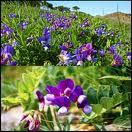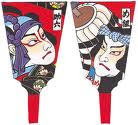[ . BACK to Worldkigo TOP . ]
:::::::::::::::::::::::::::::::::::::::::::::::::::::::::::::::::::::::::::::::::::::::::::::::::::::
Red autumn leaves, red leaves (momiji)
***** Location: Japan, other countries
***** Season: Late Autumn
***** Category: Plant/Humanity/Obeservances
*****************************
Explanation
A word of caution:
The words LEAF, LEAVES, BLATT, BLÄTTER ...
are NOT kigo, but topics for haiku.
Many trees have leaves in all seasons.
. Leaves in all seasons .
:::::::::::::::::::::::::::::::::::::::::::::::::::::::::::::::::::::::::::::::::::::::::::::::::::::
 Koshihata Village, Okayama
Koshihata Village, Okayama
The red leaves, colored leaves,
momiji (kooyoo 紅葉) ,
are usually the subject of "hunting for them".
Yellow leaves are of course also part of the momiji kigo 紅葉
Red maple leaf, red maple leaves.
Red autumn colors, and other translations are possible.
The word maple leaf (kaede no ha カエデの葉) is not a kigo.
By changing the Chinese characters, we can distinguish between
紅葉
red autumn leaves
黄葉
yellow autum leaves
momiizuru もみいづる red autumn leaves
... momizuru もみづる
.................................................................................
na no ki momiji 名木紅葉(なのきのもみじ)
red autum leaves from special trees
urushi momiji 漆紅葉(うるしもみじ)momiji of the laquer tree
..... nurude momiji 白膠紅葉(ぬるでもみじ)
haze momiji 櫨紅葉(はぜもみじ)momiji of the wax tree
ichoo momiji 銀杏黄葉(いちょうもみじ)momiji of the gingko tree
kashiwa mojimi 柏黄葉(かしわもみじ)momiji of the Kashiwa oak
kaki momiji 柿紅葉(かきもみじ)momiji of the persimmon tree
ume momiji 梅紅葉(うめもみじ)momiji of the plum tree
nemu momiji 合歓紅葉(ねむもみじ)momiji of the mimosa tree
toodan momiji 満天星紅葉(どうだんもみじ)
momiji of Enkianthus perulatus
budoo momiji 葡萄紅葉(ぶどうもみじ)momiji of grapes
shirakaba momiji 白樺黄葉(しらかばもみじ)momiji of the birch tree
zooki momiji 雑木紅葉(ぞうきもみじ)momiji of miscellaneous small trees
teriha 照葉(てりは) "shining leaves"
yuumomiji 夕紅葉(ゆうもみじ)momiji in the evening
mura momiji むら紅葉(むらもみじ)momiji in the village
shita momiji, shitamomiji 下紅葉(したもみじ) lit."lower momiji"
refers to the lower red leaves of a tree or the red leaves covering the ground
tani momiji 谿紅葉(たにもみじ)momiji in the valley
niwa mojimi 庭紅葉(にわもみじ)momiji in the garden
momijigawa 紅葉川(もみじがわ)river with momiji
momijiyama 紅葉山(もみじやま)mountain with momiji
momiji no fuchi 紅葉の淵(もみじのふち)river edge with momiji
momiji no kasa 紅葉の笠(もみじのかさ)
Tatsutagusa 龍田草(たつたぐさ)momiji of Tatsuta
. 竜田姫, Princess Tatsuta of Autumn .
iromigusa 色見草(いろみぐさ)momiji of kaede mapel
tsumagoigusa 妻恋草(つまこいぐさ)
"plant to make me love my wife"
.................................................................................
"hunting for red leaves" momijigari
紅葉狩 (もみじがり)
going out to enjoy a picnick and the colored leaves of autumn. The famous temples of Kyoto and in other area were especially crowded during this season.
.... momiji mi 紅葉見(もみじみ)
..... kanpuu 観楓(かんぷう)
stepping on red leaves, momiji fumu 紅葉踏む(もみじふむ)
rice wine drunk whilst watching red leaves,
momijizake紅葉酒(もみじざけ)
tea house from where to watch red leaves, momiji chaya
紅葉茶屋(もみじぢゃや)
ship from which to enjoy red leaves, momijibune
紅葉舟(もみじぶね)
bonfire with red leaves, momiji taku 紅葉焚く(もみじたく)
enjoying the season of red leaves at the Imperial Palace
momiji no ga 紅葉の賀 もみじのが
watching red leaves at the Imperial Palace,
..... aki no gyoyuu 秋の御遊(あきのぎょゆう)
.................................................................................
kigo for mid-autumn
. leaf month, hazuki 葉月 (はづき) .
(the 8th month in the Asian lunar calendar, now September)
. hazukijio 葉月潮(はづきじお)tide of the eighth lunar month .
hatsu mojiji 初紅葉 (はつもみじ) first red autumn leaves
usumomiji, usu mojiji 薄紅葉 (うすもみじ ) "thin red autumn leaves"
(just beginning to take on color)
.................................................................................
kigo for early autumn
. "bridge of red leaves" momiji no hashi
紅葉の橋(もみじのはし) .
another name for the two stars of the Tanabata Star Festival.

momiji no tobari 紅葉の帳(もみじのとばり) "balance book in red" like the autumn leaves.
During the rituals at the Imperial court, whith the music of koto and other instruments.
(for the Tanabata Star Festival)
. kaji no ha 梶の葉 (かじのは ) paper mulberry leaf .
to write poetry for the Tanabata Star Festival
.................................................................................
kigo for late autumn
. momijizuki 紅葉月(もみはづき)month with red leaves .
(the 9th month in the Asian lunar calendar, now October)
nishikigi 錦木 (にしきぎ)
momiji of the winged spindle-tree
Euonymus alatus
..... nishikigi no mi 錦木の実 fruit of the winged spindle-tree
kooyoo 黄葉 こうよう
yellow autumn leaves
momiji もみじ、momijiba もみじば
momiji suru kusaki 黄葉する草木(もみじするくさき)
trees and plants with yellow autumn leaves
momiji katsu chiru 紅葉かつ散る (もみじかつちる)
red leaves falling
iroha chiru 色葉散る(いろはちる)colored leaves are falling
iro nagara chiru 色ながら散る(いろながらちる)
"still colorful but falling"
konoha katsu chiru 木の葉かつ散る(このはかつちる)
leaves of trees are falling
kooraku 黄落 (こうらく)
"yellow is falling"
kooraku ki 黄落期(こうらくき)
time of yellow (and red) leaves falling
hahaso momiji 柞紅葉 Japanese Emperor Oak momiji
Quercus dentata
nara momiji 楢紅葉(ならもみじ) Quercus serrata
. Kaede 楓 Maple Tree .
and maple syrup
kaede and momiji vocabulary :
Ao momiji (green maples)
Haji momiji (sumac maples)
Kaede momiji (downy maples)
Kurenai momiji (pink maples)
Moriji momiji (mixed maples)
Momiji no samazama (diverse maples)
Ki momiji (yellow maples)
:::::::::::::::::::::::::::::::::::::::::::::::::::::::::::::::::::::::::::::::::::::::::::::::::::::
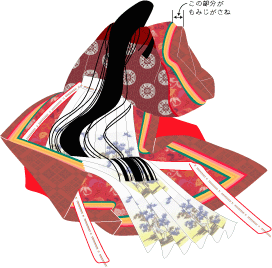 special robe for watching red leaves, momiji goromo
special robe for watching red leaves, momiji goromo
紅葉衣 (もみじごろも)
..... momiji gasane 紅葉重(もみじがさね)

:::::::::::::::::::::::::::::::::::::::::::::::::::::::::::::::::::::::::::::::::::::::::::::::::::::
Please read the entry about the human activities for further explanation.
Leaf Watching, leaf peeping Momijigari
:::::::::::::::::::::::::::::::::::::::::::::::::::::::::::::::::::::::::::::::::::::::::::::::::::::
bitterling, broad-striped, green-striped
momiji tanago 紅葉たなご (もみじたなご)
"bitterling like red leaves"
reddened carp, momijibuna, momiji-buna
紅葉鮒 (もみじぶな)
Literally: Carp like red leaves.
landlocked salmon "among the leaves", konoha yamame
木の葉山女
a kind of trout.
. Fish in Autumn .
:::::::::::::::::::::::::::::::::::::::::::::::::::::::::::::::::::::::::::::::::::::::::::::::::::::
kigo for winter
red leaves in winter, fuyu momiji
冬紅葉 (ふゆもみじ)
red leaves still left over, nokoru momiji 残る紅葉(のこるもみじ)
red leaves scattering, momiji chiru
紅葉散る (もみじちる)
..... chiri momiji 散紅葉(ちりもみじ)
:::::::::::::::::::::::::::::::::::::::::::::::::::::::::::::::::::::::::::::::::::::::::::::::::::::
Memorial Day of Osaki Koyo
(Oosaki Kooyoo 尾崎 紅葉(おざき こうよう)
Kooyoo ki 紅葉忌 (こうようき ) "Red leaves memorial day"
Tochiman Doo Ki 十千万堂忌(とちまんどうき)
Koyo was a novelist, his most famous novel was
Tochiman Doo.
慶応3年12月16日(1868年1月10日) - 明治36年(1903年)10月30日)
Osaki Koyo (1867–1903)
blazing sun —
whose barefoot child
is running free
Cayır cayır güneş—
Kimin yalınayak çocuğu
ki böyle koşar.
Under the night moon,
playing the flute quite badly—
my neighbor—listen.
Gece mehtapta
Flütü çok kötü çalar—
Komşum— Dinle bak!
© Çeviri: Turgay Uçeren
:::::::::::::::::::::::::::::::::::::::::::::::::::::::::::::::::::::::::::::::::::::::::::::::::::::
Now I will add some more pictures and haiku.
At the
temple Daiyuu-zan 大雄山 in Kanagawa Pref.
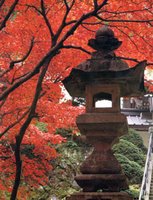 http://www.daiyuuzan.or.jp/
http://www.daiyuuzan.or.jp/
xxxxxxxxxxxxxxxxxxxxxxxxxxxxx
Japanese Haiku and Photos, Toori Gallery
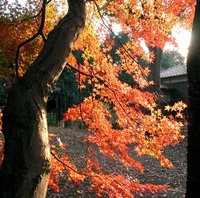
紅葉狩まずは田楽食べてをり
http://www.interone.jp/~touri/garo/garo.htm
xxxxxxxxxxxxxxxxxxxxxxxxxxxxx
A carpet of colored leaves.

Yamashina, Bishamon-Doo, Kyoto.
Look at a lot more autumn pictures.
http://www.eonet.ne.jp/~kikusui/sub18.htm
*****************************
Worldwide use
USA
Fall color frames Attic Window peak on Grandfather Mountain near Linville, N.C., Saturday, Sept. 25, 2004 fro just below the Blue Ridge Parkway Viaduct. Despite flooding from Hurricanes Ivan and France, all sections of the Blue Ridge Parkway north of Linville Falls are now open as the fall viewing season begins. (AP Photo/Grandfather Mountain, Hugh Morton)
http://news.yahoo.com/news?tmpl=story&u=/040925/480/nccb20109251957
*****************************
Things found on the way
momiji nu, momijinu もみじ ぬ
the absence of autumn colors
This has also been the subject of poetry since olden times.
樫の葉の もみじ ぬからにちりつもる
奥山寺のさびしさよ
Leaves of oak trees
fallen before they become
red and yellow.
Loneliness of a temple
faraway in the mountain
source : rakushin sha
There is also a positive
verb
momizu もみず【紅葉づ/黄葉づ】
to become red and yellow with autumn leaves
:::::::::::::::::::::::::::::::::::::::::::::::::::::::::::::::::::::::::::::::::::::::::::::::::::::

food plate called
ship from which to enjoy red leaves, momijibune
紅葉舟(もみじぶね)
:::::::::::::::::::::::::::::::::::::::::::::::::::::::::::::::::::::::::::::::::::::::::::::::::::::
:::::::::::::::::::::::::::::::::::::::::::::::::::::::::::::::::::::::::::::::::::::::::::::::::::::::::::::::::::::::::::
senryu from Edo 江戸の川柳
紅葉狩り例年行けどいまだ見ず
momijigari reinen ikedo imada mizu
viewing the red maple leaves
they go for it every year
but have not seen them yet
This refers to the menfolk of Edo.
There were two famous momiji spots, but one was close to the pleasure quarters of Yoshiwara 吉原 and the other further down, also near the cheaper pleasure quarters.
So . . . when the menfolk took off with the excuse of enjoying the red autumn leaves, . . .
. senryu, senryū 川柳 Senryu in Edo .
:::::::::::::::::::::::::::::::::::::::::::::::::::::::::::::::::::::::::::::::::::::::::::::::::::::::::::::::::::::::::::
. Momiji Daruma .
:::::::::::::::::::::::::::::::::::::::::::::::::::::::::::::::::::::::::::::::::::::::::::::::::::::
. momiji manjuu もみじ饅頭 bean paste buns.
from Miyajima, Hiroshima
Manju in der Form von Ahornbälttern
. Momiji tenpura 紅葉の天ぷら tempura from maple leaves .
*****************************
HAIKU
Japanese Haiku and Photos, Toori Gallery
紅葉狩まずは田楽食べてをり... 雛菊
紅葉
http://www.interone.jp/~touri/garo/garo.htm
武蔵野や桜紅葉に夜の雨
ぽぽな
Musashino Plain -
red leaves of cherries
in evening rain
どうしたらいいのか紅葉ちりやまず
雪女
what best to do?
the red leaves
keep falling
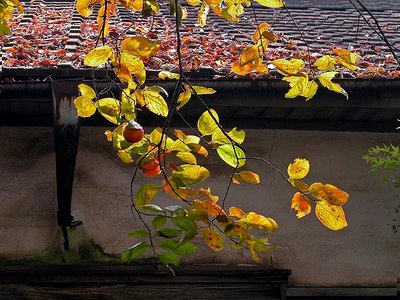 http://www.interone.jp/~touri/garo/image/yurikaki.jpg
. WKD : Musashino Plain 武蔵野 .
http://www.interone.jp/~touri/garo/image/yurikaki.jpg
. WKD : Musashino Plain 武蔵野 .
:::::::::::::::::::::::::::::::::::::::::::::::::::::::::::::::::::::::::::::::::::::::::::::::::::::
Zen garden -
goldfish and maple leaves
the same deep red
Andre Surridge, 2006 NZ
xxxxxxxxxxxxxxxxxxxxxxxxxxxxx
autumn -
leaves with patterns
to wonder and ponder
Look at my leaf collection here !
Gabi Greve, Autumn 2006
:::::::::::::::::::::::::::::::::::::::::::::::::::::::::::::::::::::::::::::::::::::::::::::::::::::
*****************************
Related words
*****
Leaf Watching momijigari 紅葉狩り
*****
Fallen leaves (ochiba) 落ち葉
***** Colored cover leaves of beech tree buds falling on snow
yuki momiji 雪もみじ , haru momiji 春もみじ
kigo for early spring
This is a phenomenon of the beech tree woods in Northern Japan. The small red leaves, which cover the buds of the beech trees during winter, fall on the snow when it gets warmer and the tree gets ready to produce new leaves. This might be as late as May.
 月山周辺
月山周辺の豊かな自然を紹介します。
五月の風物詩・まさに東北の原風景とも言える「春もみじ」と「雪もみじ」と「根開き」の三点セットが園内にでそろいました。
http://blog.yahoo.co.jp/gassan_bunarin/3139817.html
:::::::::::::::::::::::::::::::::::::::::::::::::::::::::::::::::::::::::::::::::::::::::::::::::::::
. Fallen leaves (ochiba 落葉)
. Leaves in all seasons .
[ . BACK to WORLDKIGO . TOP . ]
:::::::::::::::::::::::::::::::::::::::::::::::::::::::::::::::::::::::::::::::::::::::::::::::::::::
